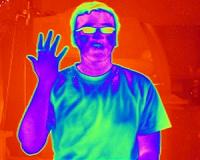 |
Houston TX (SPX) Dec 10, 2010 Physicists from Rice University and Princeton University have discovered how to use one of the information technology industry's mainstay materials - gallium arsenide semiconductors - as an ultrasensitive microwave detector that could be suitable for next-generation computers. The discovery comes at a time when computer chip engineers are racing both to add nanophotonic devices directly to microchips and to boost processor speeds beyond 10 gigahertz (GHz). "Tunable photon-detection technology in the microwave range is not well-developed," said Rice physicist Rui-Rui Du, the study's lead author. "Single-photon detectors based on superconductors in the 10-GHz to 100-GHz range are available, but their resonance frequency has been difficult to tune. Our findings suggest that tunable single-photon detection may be within reach with ultrapure gallium arsenide." The study, which is available online and due to appear in print this week in Physical Review Letters, is the latest result from a long-term collaboration between Du and Princeton University physicist Loren Pfeiffer, whose group produces the world's purest samples of gallium arsenide. For the new study, Rice graduate student Yanhua Dai cooled one of Pfeiffer's ultrapure samples to below 4 degrees Kelvin - the temperature of liquid helium. She then bombarded the sample with microwaves while applying a weak magnetic field - approximately the same strength as that of a refrigerator magnet. Du and Dai were surprised to find that microwaves of a specific wavelength resonated strongly with the cooled sample. They also found they could use the magnet to tune this resonance to specific microwave frequencies. Du said previous experiments have typically measured weak resonance effects from microwaves. "A signal level of 1 percent is a common measurement. In our case, the change was a thousand times that much." While the team does not yet understand the mechanism that leads to such a sensitive reaction, they are eagerly pursuing follow-up research to try to prove they can use the effect for single-photon measurements. A photon is the smallest possible unit of light or electromagnetic radiation. By incorporating devices that create, transmit and measure digital information via photons, rather than with electrons, makers of computer chips hope to produce computers that are both faster and more powerful. "The clock speed of a new computer right now is about 2 GHz," Du said. "For the next generation, the industry is shooting for around 100 GHz, which is a microwave device. The phenomenon we've observed is in this region, so we hope it may be useful for them." Additional co-authors include Princeton scientist Ken West. The research was supported by the National Science Foundation.
Share This Article With Planet Earth
Related Links Rice University Computer Chip Architecture, Technology and Manufacture Nano Technology News From SpaceMart.com
 High Performance Infrared Camera Based On Type-II InAs GaSb Superlattices
High Performance Infrared Camera Based On Type-II InAs GaSb SuperlatticesEvanston IL (SPX) Dec 06, 2010 Researchers at Northwestern University have created a new infrared camera based on Type-II InAs/GaSb superlattices that produces much higher resolution images than previous infrared cameras. Created by Manijeh Razeghi, Walter P. Murphy Professor of Electrical Engineering and Computer Science, and researchers in the Center for Quantum Devices in the McCormick School of Engineering and Appli ... read more |
|
| The content herein, unless otherwise known to be public domain, are Copyright 1995-2010 - SpaceDaily. AFP and UPI Wire Stories are copyright Agence France-Presse and United Press International. ESA Portal Reports are copyright European Space Agency. All NASA sourced material is public domain. Additional copyrights may apply in whole or part to other bona fide parties. Advertising does not imply endorsement,agreement or approval of any opinions, statements or information provided by SpaceDaily on any Web page published or hosted by SpaceDaily. Privacy Statement |